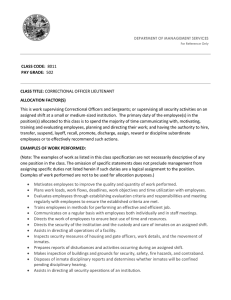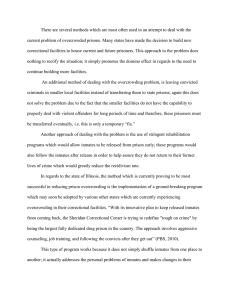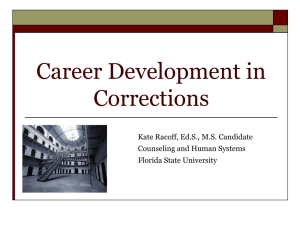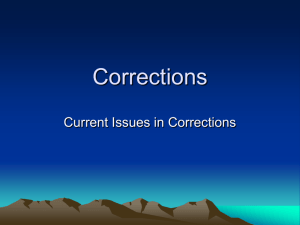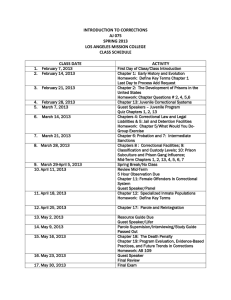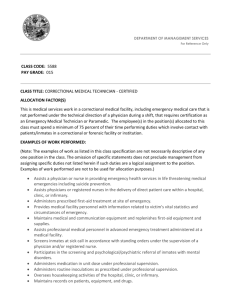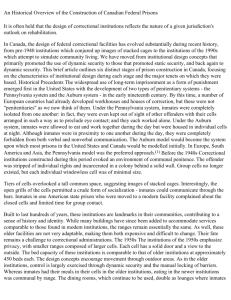Document 10454225
advertisement
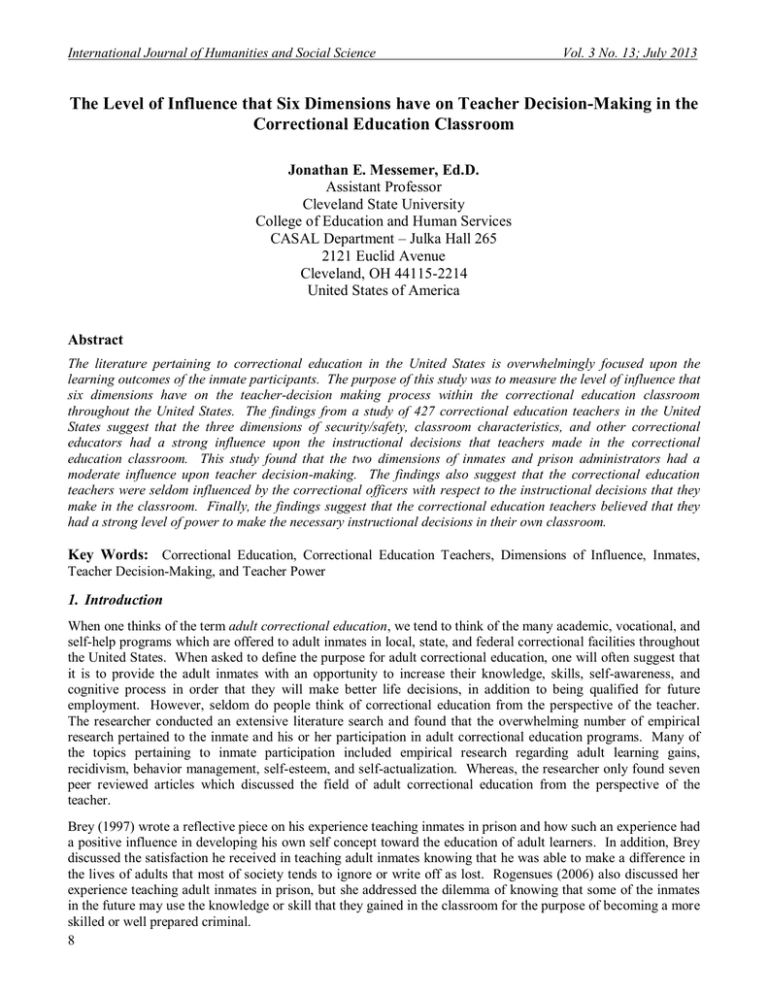
International Journal of Humanities and Social Science Vol. 3 No. 13; July 2013 The Level of Influence that Six Dimensions have on Teacher Decision-Making in the Correctional Education Classroom Jonathan E. Messemer, Ed.D. Assistant Professor Cleveland State University College of Education and Human Services CASAL Department – Julka Hall 265 2121 Euclid Avenue Cleveland, OH 44115-2214 United States of America Abstract The literature pertaining to correctional education in the United States is overwhelmingly focused upon the learning outcomes of the inmate participants. The purpose of this study was to measure the level of influence that six dimensions have on the teacher-decision making process within the correctional education classroom throughout the United States. The findings from a study of 427 correctional education teachers in the United States suggest that the three dimensions of security/safety, classroom characteristics, and other correctional educators had a strong influence upon the instructional decisions that teachers made in the correctional education classroom. This study found that the two dimensions of inmates and prison administrators had a moderate influence upon teacher decision-making. The findings also suggest that the correctional education teachers were seldom influenced by the correctional officers with respect to the instructional decisions that they make in the classroom. Finally, the findings suggest that the correctional education teachers believed that they had a strong level of power to make the necessary instructional decisions in their own classroom. Key Words: Correctional Education, Correctional Education Teachers, Dimensions of Influence, Inmates, Teacher Decision-Making, and Teacher Power 1. Introduction When one thinks of the term adult correctional education, we tend to think of the many academic, vocational, and self-help programs which are offered to adult inmates in local, state, and federal correctional facilities throughout the United States. When asked to define the purpose for adult correctional education, one will often suggest that it is to provide the adult inmates with an opportunity to increase their knowledge, skills, self-awareness, and cognitive process in order that they will make better life decisions, in addition to being qualified for future employment. However, seldom do people think of correctional education from the perspective of the teacher. The researcher conducted an extensive literature search and found that the overwhelming number of empirical research pertained to the inmate and his or her participation in adult correctional education programs. Many of the topics pertaining to inmate participation included empirical research regarding adult learning gains, recidivism, behavior management, self-esteem, and self-actualization. Whereas, the researcher only found seven peer reviewed articles which discussed the field of adult correctional education from the perspective of the teacher. Brey (1997) wrote a reflective piece on his experience teaching inmates in prison and how such an experience had a positive influence in developing his own self concept toward the education of adult learners. In addition, Brey discussed the satisfaction he received in teaching adult inmates knowing that he was able to make a difference in the lives of adults that most of society tends to ignore or write off as lost. Rogensues (2006) also discussed her experience teaching adult inmates in prison, but she addressed the dilemma of knowing that some of the inmates in the future may use the knowledge or skill that they gained in the classroom for the purpose of becoming a more skilled or well prepared criminal. 8 © Center for Promoting Ideas, USA www.ijhssnet.com Rogensues stated, “I have found that the most challenging part of my job is to bridge the gap between what they need to know and what inmates want to know” (p. 32). Wright (2004) suggests that in order to make a significant difference in the lives of adult inmates, it is vital for the adult educator to develop a caring relationship with the adult learner. Wright addresses the cultural aspects of prison in that it focuses upon safety and control to the point of creating an environment of “cruelty, sadism, abuse, and neglect” (p. 198). He stated that “some prisons make it difficult for care to appear” (p. 198). However, Cervero and Wilson (1994 & 2006) suggest that organizations do not plan programs, rather people do. Likewise, prisons do not set the tone for developing caring relationships within the correctional facilities; rather it is up to those who work within the prison walls to develop the proper environment which will lead to redemption, thus allowing inmates to believe that they can receive a second chance. Wright (2004) does suggested that caring relationships are present when one is engrossed in the life of another person. He states that “the school is potentially a site of resistance as teachers work through the dynamics of independence and dependence. They immerse themselves and students in future-oriented practices. In caring relationships, there is hope” (p. 202). Ben-Tsur (2007) conducted a qualitative case study of Israeli teachers working with Palestinian prisoners and how the teachers had to learn to ignore the political conflict between the two cultural groups for the purpose of providing educational programs for the inmates. While they knew that many of the Palestinian inmates were tied to terroristic behavior in Israel, the “teachers set aside their emotional and political views in order to fulfill their duty in a manner that is as professional as possible” (p. 121). However, Ben-Tsur also stated, “Those teachers who expressed fear explained that they were worried about their personal safety” (p. 119). There were some Israeli teachers who did hold strong feelings toward the Palestinian inmates, which “ranged from anger, professional neutrality, and even sympathy” (p. 120). Gathright (1999) discussed the development of many cognitive programs for the purpose of addressing many of the areas of conflict that tend to occur within the correctional facility and providing a new approach to prison management. Many of the conflict issues within the correctional facilities in the United States can be contributed to the fact that many of the prisons are being harnessed as a replacement for the mental health system (Adler, 1986). McGee and Wolford (1998) discussed the implication of the Kentucky Education Reform Act in 1990 and how it sought to promote the necessary professional development to teachers who were new to the prison environment. Finally, Zaro (2007) discussed the development and implementation of educational programs for inmates that address what they identify as the four cognitive areas which lead to criminal behavior or inmate recidivism. The four cognitive areas addressed in this case was responsibility, controlling impulsiveness, anger management, and empathy. In order for these programs to work, Zaro suggests that is important for teachers to become selfactualized in their teaching methods in that they do not rely upon those employed by the prison facility to implement the programs. The purpose of this investigation is to study the dimensions that influence teacher decision-making in the adult correctional education classroom. While these seven articles dealt with some important issues that correctional education teachers have to encounter on a daily basis, the author does not view such topics as teacher/learner relationships, professional development, and political conflict as the over arching issues that influence the teachers’ decision-making in the classroom (Ben-Tsur, 2007; Brey, 1997; McGee & Wolford, 1998; Rogensues, 2006; Wright, 2004). The researcher does acknowledge that the subject areas pertaining to conflict (Gathright, 1999), safety (BenTsur, 2007; Rogensues, 2006), and cognitive skills (Zaro, 2007) make a stronger case for influencing the teachers’ classroom decisions. Therefore, the researcher decided to conduct a more extensive literature search regarding empirical studies that pertained to the teachers’ instructional decision in the classroom. 2. Review of the Literature Following an extensive review of the literature, the researcher did not find any empirical studies that looked at teacher decision-making within the fields of adult education and correctional education. Because the majority of correctional education curriculum consist of ABE and GED programs, the overall structure of these programs tend to mirror that of most normal elementary and secondary education programs. For example, the majority of public and private K-12 schools operate using a top-down organizational design system, which consists of the superintendent, principal, academic advisors, and teachers. In correctional education, the organizational design system is very similar in that it consists of the prison warden, educational director, academic advisors, and teachers. 9 International Journal of Humanities and Social Science Vol. 3 No. 13; July 2013 The superintendent has the role of overseeing the entire K-12 system for a particular school district, thus making sure that all of the policies and procedures established by the school board are met. Within a prison system, the warden serves essentially the same function of overseeing the entire prison facility including the educational program, making sure that it functions within the framework of the policies, and procedures set forth by the state department of corrections. The principal in a K-12 school system has the responsibility of supervising and controlling the daily flow of education within a particular school building. In correctional education, the educational director in the prison serves the same function as a school principal. However, because state correctional systems are operating on strict economic budgets, often the prison warden will assign a deputy warden to serve the function of educational director. In essence, the working relationship between the teachers and educational director in a prison facility is very similar to the working relationship between the teachers and principal in a K-12 school. Because the organizational design of a correctional education program is similar to that of a K-12 school program, the researcher chose to conduct a literature search involving teacher decisionmaking within the fields of elementary and secondary education. This particular literature search registered eight empirical studies. One of the first empirical studies from Clear (1968) sought to look at how professional position and authority had an influence on the decisions social studies teachers made in their classroom. His study first found that the department chairperson had little or no influence over the decisions teachers made regarding the social studies classroom instruction. Secondly, Clear found that the principal was not perceived by the teachers as a source of instructional leadership. Thirdly, the principal was perceived by the teachers to be a threat to their professional status as teachers. In contrast, the department chairperson was perceived by the teachers to be a semi-colleague who did not pose the same level of threat. In a similar study, Chapel (1990) found that if the principal played an active role in supporting the class and if the teachers were comfortable with their knowledge of the cooperative learning methods, then the teachers were more likely to use cooperative learning techniques in the classroom. Owens (1981) sought to study whether teachers’ educational beliefs coincided with their teaching practices with regard to the teachers’ instructional decisions made in the classroom. Owens’ findings suggested that teachers did not discriminate between their theoretical beliefs concerning education with regard to the three educational theories delineated in this study: behaviorism, experimentalism, and humanism. The findings also suggest that teachers identified with no dominant educational theory. With respect to educational practice, this study found that teachers were more likely to identify with one prevailing educational theory than to employ from a combination of theories. Finally, Owens suggests that this study indicate that “teachers do not appear to consider objectives as a starting point for lesson preparation nor do they consider evaluation decisions to be a priority during the teacher preparation routine” (p. 148). Hicks (1990) studied secondary education teachers in Kentucky with respect to their perceived level of freedom to make instructional decisions in the classroom. Hicks discovered four major points. Hicks found that female teachers perceived themselves as having more freedom in making instructional decisions regarding classroom objectives, interactions, methods, materials, and the total score than the male teachers. Secondly, teachers working in smaller school districts were perceived to have more instructional freedom than the teachers working in much larger school districts. Hicks also found that those with more teaching experience within the school district were more likely to perceive themselves as having more control over the instructional decisions in their classroom. Finally, Hicks found that when teachers who held membership in subject oriented professional organizations, they perceived themselves as having more control over their instructional decisions in the areas of interactions, content, and methods. Smylie (1992) studied willingness of K-8 teachers, from a Midwest metropolitan school district that employed over 200 classroom teachers, to participate in the school decision-making process. This study suggest that teachers who had good working relationships with the school principal and professional privacy with respect to the working relationships of their colleagues were more willing to participate in curricular and instructional decisions. This study also found that the teachers’ working relationship with the school principal dictated the willingness of teachers engage in decisions regarding personnel, staff development, and general administrative issues. Among more recent studies, Guo, Justice, Sawyer, and Tompkins (2011) found that a high level of teacher collaboration had a significant influence upon the pre-school teachers’ level of self-efficacy. 10 © Center for Promoting Ideas, USA www.ijhssnet.com Frost (2010) found that the personal and professional experiences of the teachers had a significant influence upon the instructional decisions made by those teaching mathematics. Finally, Marks and Nance (2007) found that school principals have a strong influence upon the instructional decisions teachers make in the classroom, with respect to state and regional control factors. 3. Interviewing Correctional Educators While the K-12 literature review on teacher decision-making in the classroom helped to illustrate additional dimensions of influence to consider, the researcher believed that it was best to discuss this matter further with those who work daily in correctional education programs. Therefore, the researcher interviewed eight teachers and two administrators who worked for an adult correctional education facility in the southeastern region of the United States. The conceptual framework for this study is based upon the works of Cervero & Wilson (1994, 2001, & 2006), Forester (1989 & 1999) and Kotler & Fox (1995). Further review of the conceptual framework for this study is illustrated in Messemer and Valentine (2012). While there are many external factors that can influence how a teacher goes about the daily routine of teaching adult inmates in prison, the researcher believed that it was important to focus his interview with teachers and administrators regarding the dimensions that teachers have some control over with respect to how they deal with the dimensions of influence. Therefore, the researcher focused primarily on the internal dimensions of influence, which occur primarily within the prison facility. Following the teacher/administrator interviews, the researcher was able to identify the stakeholders who are internal to the immediate educational program and who had a direct influence upon the teachers’ decisions in the correctional education classroom. For this study, the internal stakeholders will be referred to as interpersonal dimensions of influence. There are four interpersonal dimensions of influence (Messemer & Valentine, 2012): the influence of prison administrators, the influence of correctional officers, the influence of other correctional educators, and the influence of inmates. The first interpersonal dimension is the influence of prison administrators. The prison administrators include the warden and educational administrators, who decide which educational programs will be supported, how the educational programs will be funded, who will serve as the teaching personnel, and which inmates will have an opportunity to attend the educational programs. The second interpersonal dimension is the influence of correctional officers. The primary role of the correctional officer is to insure the safety of all individuals within the prison facility. As a result, many correctional officers serve the function of planning the daily routine of the inmates, which include their education schedule. To some extent, the correctional officers can determine which inmates can attend class on a particular day and which inmates cannot due to some disciplinary infraction. The third interpersonal dimension is the influence of other correctional educators. This group of educators consists of the teacher’s colleagues (e.g., other teachers) and the educational counselors who serve the role of testing and placement of inmates in the correctional educational program. The fourth interpersonal dimension is the influence of inmates who attend the educational program in prison. Also steaming from the teacher/administrator interviews, the researcher discovered that while the interpersonal dimensions can have a direct influence upon the decisions of teachers in a correctional education classroom, equally one cannot underestimate the influence the contextual dimensions have upon the teachers’ decisionmaking process. In correctional education, there are two primary contextual dimensions of influence (Messemer & Valentine, 2012): classroom influences and security/safety influences. As in the case of all adult education programs, correctional education teachers must plan according to the size of the classroom, the class enrollment, the classroom layout, the educational materials, the level of classroom technology, and the accessibility for students with physical disabilities. However, one contextual constraint which correctional education teachers must plan around which most adult educators do not have to consider includes the security/safety influence. 11 International Journal of Humanities and Social Science Vol. 3 No. 13; July 2013 Because the correctional education teachers are teaching within a prison environment, they must adhere to the many policies of the prison facility regarding security when making educational decisions in the classroom. Correctional education teachers are required to work in conjunction with correctional officers in maintaining a safe learning environment for the inmates, while always being aware of the social climate among the inmate population. 4. Statement of the Problem Although the four interpersonal dimensions of influence (prison administrators, correctional officers, other correctional educators, and inmates) and the two contextual dimensions of influence (classroom and security/safety) named in the above section are logically defensible and readily apparent to many correctional educators, there are no empirical studies that assess how these factors affect the instructional decision-making process. The six dimensions are widely accepted by many people, but there is little empirical evidence to warrant the level of its influence. In order to better understand how influences operate on instructional decision-making, we need to understand both the importance that correctional educators assign to each of these dimensions and the way in which these dimensions impact an overall sense of teacher power. 5. Purpose of the Study The purpose of this study was to better understand the dimensions of influence that affect instructional decisions made by correctional educators. This study measures two broad dimensions of influence: interpersonal dimensions of influence (prison administrators, correctional officers, other correctional educators, and inmates) and contextual dimensions of influence (classroom and security/safety). For the purpose of this paper, the researcher will only focus only on the descriptive data with respect to the research questions. Therefore, two research questions drove this study: 1. To what extent do the six dimensions have toward influencing teacher decision-making in the correctional education classroom? 2. Which factors among the six dimensions of influence had the most impact upon the decisions teachers make in the correctional education classroom? 6. Sample The sample for this study consisted of 427 correctional education teachers who worked in adult prison facilities in the United States. The sample was generated from adult prison facilities that are listed in a directory of U.S. correctional institutions (American Correctional Association, 2010). The sample had a mean age of 51.7 years and a mean of 9.4 years of professional experience teaching inmates within a prison facility. The sample consisted of 52.7% (n=225) female teachers, while 88.3% (n=377) of the teachers were White. Among the teachers of Color, they could be categorized as African-American (n=27), American-Indian (n=8), Hispanic/Latin American (n=8), and Asian (n=7). 7. Data Analysis The primary purpose for this study was to measure the influence the six dimensions had on the teacher decisionmaking in the correctional education classroom. This paper represents the first of many subsequent papers pertaining to the findings of this study. Because this is a landmark study on teacher decision-making in the correctional education classroom, the researcher believed that for the purpose of this paper the data should be analyzed primarily with respect to the descriptive data. Therefore, researcher measured the mean scores among the six dimensions of influence in order to address the first research question. As for the second research question, the researcher measured the mean scores for each of the items represented among the six dimensions of influence. In both cases, the sample consisted of 427 teachers who taught within correctional facilities. 8. Research Findings This chapter will present the results of the statistical analysis described in the preceding chapter. The purpose of this study was to better understand the dimensions of influence that affect instructional decisions made by correctional educators. This study measures two broad dimensions of influence: interpersonal dimensions of influence (prison administrators, correctional officers, other correctional educators, and inmates) and contextual dimensions of influence (classroom and security/safety). The researcher will discuss the findings of this study with respect to the two research questions. 12 © Center for Promoting Ideas, USA www.ijhssnet.com Findings Related to Research Question #1 The first research question asked, “To what extent do the six dimensions have toward influencing teacher decision-making in the correctional education classroom?” A mean-item-mean was calculated for each of the six dimensions of influence on teachers’ decision-making in the correctional education classroom. The mean-itemmean scores for the six dimensions of influence are shown in Table 1. This was accomplished by calculating the mean for each of the item-means within each construct. The results of the mean-item-mean, on a scale of one (strongly disagree) to six (strongly agree), suggests that the security/safety dimension demonstrated the strongest influence on the teachers’ instructional decision-making, with a mean-item-mean of 4.59. The results suggests that the classroom characteristics dimension and the other correctional educators dimension also had a strong influence upon the teachers’ instructional decision-making, thus demonstrating mean-item-mean values of 4.48 and 4.36 respectively. The results suggest that the inmate dimension and the prison administrator dimension had a slight influence on the teachers’ decision-making in the correctional education classroom, thus demonstrating mean-item-mean values of 3.94 and 3.71 respectively. The lowest mean-item-mean of 2.87 is found in the correctional officer dimension of influence. The correctional officer influence is the only dimension that fell below the theoretical mean of 3.50, thus suggesting that this construct had little influence upon the teachers’ decision-making in the correctional education classroom. Table 1: Mean Scores for the Six Dimensions of Influence (n=427) Rank 1 2 3 4 5 6 Dimension of Influence Security/Safety Classroom Characteristics Other Correctional Educators Inmates Prison Administrators Correctional Officers Mean 4.59 4.48 4.36 3.94 3.71 2.87 SD 1.14 1.02 1.11 0.86 1.18 1.13 Findings Related to Research Question #2 The second research question asked “Which factors among the six dimensions of influence had the most impact upon the decisions teachers make in the correctional education classroom?” Mean scores ranged from 2.10 to 5.50 on a 1 (strongly disagree) to 6 (strongly agree) point scale. The total rank order of the 40-item scale, representing the six dimensions of influence on teacher decision-making, is shown in Table 2. However, in order to develop a clearer picture as to the importance of the six dimensions of influence, the researcher will rank order the items within each of the six dimensions of influence. The first dimension consists of the influence prison administrators had on the teachers’ instructional decisions in the classroom. The rank order of the mean scores for the prison administrator influence is shown in Table 2. The mean scores suggest that the teachers’ instructional decisions are strongly influenced by the prison educational administrators. In contrast, the mean scores suggest that the prison warden’s have little influence over the instructional decisions the teachers make in the classroom. The total mean for the three educational administrator items (Items 4-6) was 4.55 in comparison to the total mean score of 2.88 for the three warden items (Items 1-3). The second dimension consists of the influence correctional officers had on the teachers’ instructional decisions in the classroom. The rank order of the mean scores for the correctional officer influence is shown in Table 2. In general, the results suggest the correctional officers have little influence on the teachers’ instructional decisions in the correctional education classroom. However, the correctional teachers suggest that their instructional decisions are strongly influenced by the correctional officers’ attitudes toward security, thus this item (Item-9) had a mean score value of 4.19. The correctional teachers also suggests that they are slightly influenced by the control the correctional officers have over the physical movements of the inmates, which includes who [inmates] attends class on a particular day. This item (Item-11) had a mean score value of 3.81. The third dimension consists of the influence other correctional educators had on the teachers’ instructional decisions in the classroom. The rank order of the mean scores for the other correctional educator influence is shown in Table 2. 13 International Journal of Humanities and Social Science Vol. 3 No. 13; July 2013 The mean scores suggest that the correctional teachers’ instructional decisions are strongly influenced by their teacher colleagues. The only area, in which the teachers occasionally network with one another in making instructional decisions, pertains to group discussions. The item (Item-15) pertaining to teacher group discussions had a mean score of 3.86, whereas the remaining teacher mean scores ranged between 4.37 and 4.56. The fourth dimension consists of the influence inmates had on the teachers’ instructional decisions in the classroom. The rank order of the mean scores for the inmate influence is shown in Table 2. According to the mean scores, the items representing the inmates’ influence on teacher decision-making can fall into three distinct groups. The first group consists of five items that the teachers rated as having a strong influence upon their instructional decision making process. These five items had a mean score range of 4.22 and 5.50. The results suggests that the teachers were strongly influenced by the inmates’ learning needs, learning disabilities, purpose for attending class, number of contact hours in class, and life experiences. The second group consists of two items whereby the teachers rated as having a slight influence upon their instructional decision-making process. These two items had a mean score range of 3.53 and 3.59. The results suggest that the teachers’ instructional decisions were slightly influenced by the inmates’ opinions of the class and the inmates’ race/ethnicity. The third group consists of three items that the teachers rated as not having any influence upon their instructional decision-making process. These three items had a mean score range of 2.12 and 3.23. The results suggest that the teachers’ instructional decisions are not influenced by the inmates’ gender, religious affiliation, and previous criminal history. The fifth dimension consists of the influence the classroom characteristics had on the teachers’ instructional decisions. The rank order of the mean scores for the classroom influence is shown in Table 2. The results suggest that the teachers’ instructional decisions are strongly influenced by the classroom characteristics. Five of the six items concerning the classroom influence index warranted mean scores that ranged between 4.36 and 5.19. The classroom characteristics for these five items pertained to the room size, classroom layout, classroom technology, number of inmates in the class, and the instructional materials. The mean-item-mean score for these five items was 4.48. The correctional teachers rated only one item (Item-32) as having a slight influence on their instructional decision-making in the classroom. This item had a mean value of 3.74 and pertained to the type of furniture in the classroom. The sixth dimension consists of the influence the security/safety requirements have on the teachers’ instructional decision-making. The rank order of the mean scores for the security/safety influence is shown in Table 2. The results suggest that the teachers’ instructional decisions are strongly influenced by security/safety concerns. The six items concerning the security/safety influence index warranted mean scores that ranged between 4.27 and 4.85. However, the total six item scale measuring how the correctional teachers rated the security/safety dimension of influence on their instructional decision-making had a total mean score of 4.59. Table 2: Rank Order of the Scale Items for Each of the Six Dimensions of Influence and the Index Measuring Teacher Power (N = 427). I. Item # 5 6 4 3 2 1 14 Prison Administrator Influence Item When making instructional decisions, I consider the requirements imposed by the educational administrators. When making instructional decisions, I consider the academic expectations of the educational administrators. When making instructional decisions, I consider the attitudes of the educational administrators. When making instructional decisions, I consider the prison warden’s attitude toward the educational program for inmates. When making instructional decisions, I consider the prison warden’s attitude toward the correctional educators. When making instructional decisions, I consider the prison warden’s attitude toward inmates. Mean 4.81 SD 1.26 4.67 1.32 4.17 1.50 3.07 1.71 2.83 1.67 2.73 1.64 © Center for Promoting Ideas, USA II. Item # 9 11 12 8 7 10 www.ijhssnet.com Correctional Officer Influence Item When making instructional decisions, I consider the correctional officers’ attitudes toward security. When making instructional decisions, I consider the control correctional officers have over the physical movements of inmates. When making instructional decisions, I consider the power correctional officers have over the classroom environment. When making instructional decisions, I consider the correctional officers’ attitudes toward the correctional educators. When making instructional decisions, I consider the correctional officers’ attitudes toward the inmates. When making instructional decisions, I seek input from correctional officers. Mean 4.19 SD 1.64 3.81 1.57 2.72 1.56 2.22 1.43 2.19 1.38 2.10 1.31 Mean 4.56 SD 1.29 4.53 1.21 4.42 1.35 4.41 1.31 4.37 3.86 1.40 1.47 III. Other Correctional Educator Influence Item # 14 13 18 16 17 15 Item When making instructional decisions, I seek input from other correctional educators about classroom problems. When making instructional decisions, I consider the recommendations from other correctional educators. When making instructional decisions, I discuss with other correctional educators issues regarding inmates. When making instructional decisions, I discuss teaching strategies with other correctional educators. When making instructional decisions, I collaborate with other correctional educators. When making instructional decisions, I have group discussions with other correctional educators. IV. Inmate Influence Item # 25 28 26 27 22 23 20 19 21 24 Item When making instructional decisions, I consider the inmates’ learning needs. When making instructional decisions, I consider the learning disabilities of some inmates. When making instructional decisions, I consider the inmates’ purpose for attending the class. When making instructional decisions, I consider the number of hours per week the inmates attend class. When making instructional decisions, I consider the inmates’ life experiences. When making instructional decisions, I consider the inmates’ opinions about the class. When making instructional decisions, I consider the race/ethnic diversity among the inmates. When making instructional decisions, I consider the gender of the inmates. When making instructional decisions, I consider the religious diversity among the inmates. When making instructional decisions, I consider the inmates’ criminal history. Mean 5.50 5.26 SD 0.79 0.98 4.58 1.33 4.39 1.40 4.22 3.59 1.44 1.37 3.53 1.68 3.23 2.97 1.81 1.62 2.12 1.37 15 International Journal of Humanities and Social Science V. Classroom Influence Item # 34 29 33 31 30 32 Vol. 3 No. 13; July 2013 Item When making instructional decisions, I consider the instructional materials available for the class. When making instructional decisions, I consider the number of inmates in the class. When making instructional decisions, I consider the level of technology available for inmates. When making instructional decisions, I consider the classroom layout. When making instructional decisions, I consider the room size. When making instructional decisions, I consider the type of furniture in the classroom. Mean 5.19 SD 0.93 4.65 1.29 4.58 1.29 4.37 4.36 3.74 1.40 1.43 1.53 Mean 4.85 4.78 SD 1.35 1.38 4.73 4.45 1.52 1.34 4.43 1.46 4.27 1.56 Mean 5.35 5.28 4.91 4.50 2.71 SD 0.98 1.04 1.30 1.32 1.64 2.42 1.49 VI. Security/Safety Influence Item # 38 36 37 39 40 35 Item When making instructional decisions, I consider the safety of the inmates. When making instructional decisions, I consider the prison’s policy toward security. When making instructional decisions, I consider my own safety. When making instructional decisions, I consider the current social climate among the inmates. When making instructional decisions, I consider previous security concerns at the prison. When making instructional decisions, I consider the level of classroom security. VII. Teacher Power Item # 44 42 43 41 46 45 Item I decide the teaching methods to use in my classroom. I decide what learning assignments the students will do in my classroom. I decide which subject matter to cover in my classroom. I feel I can do what I want to do in my classroom. Sometimes I feel that I do not have the opportunity to be creative in my classroom. (Reverse Item) Sometimes I feel like other people are really making the important decisions in my classroom. (Reverse Item) The second part of the questionnaire consists of a 6-item scale (items 41-46) designed to measure the level of power the correctional education teachers believed that they had to make instructional decisions in the classroom. Items 45 and 46 consisted of negative items for testing a false-positive statistic. The mean item-means ranged from 3.42 to 5.35 on a 1 (strongly disagree) to 6 (strongly agree) point scale. The 6-item scale is depicted in Table 2. The four positive items (items 41-44) warranted mean item-means equal to or greater than 4.50, thus suggesting that the teachers believed that that they had the power to make the necessary instructional decisions in the correctional education classroom. For two items, the teachers rated their own level of power to decide the students’ learning assignments (item 42) and teaching methods (item 44) for the class, as 5.28 and 5.35 respectively. As one would expect, the two negative items (items 45 and 46) had a mean item-mean score of 2.42 and 2.71 respectively, which represented the two lowest mean item-means for the power construct. 16 © Center for Promoting Ideas, USA www.ijhssnet.com This finding discounts any notion that a false-positive outcome has occurred. Therefore, when the scores for items 45 and 46 are reversed to resemble positive items, then items 45 (M=4.58) and 46 (M=4.29) become complimentary to the positive findings found in items 41-44 of the power construct. 9. Discussion The findings from this study suggest that the most influential dimension in the correctional education classroom is security and safety. This particular finding is likely not that surprising to those who work within a correctional environment. In fact, every activity that occurs within a prison facility is well planned, designed, and implemented in order to best guarantee the safety of all prison personnel, inmates, and visitors. The teachers in this study suggested that they were most interested in securing the safety of their adult learners, making sure that they abided by all prison policies and procedures regarding safety when teaching, and also paid attention to their own safety. The teachers identified the classroom constraints as the second dimension of influence regarding their classroom decisions. Without a doubt, the teachers believed that the most influential classroom constraint was the instructional materials which were available for the class. This is a very common factor in adult education, as we are often dependent upon the amount of academic resources that are available for us to use in the classroom. The teachers did acknowledge that the number of adult learners, the level of technology available, and the room size and layout has some influence upon their classroom decisions. These factors are also items that nearly all adult educators must consider when developing and implementing an adult education program to adult learners regardless of its location. The teachers identified other correctional educators as the third highest rated dimension of influence regarding their classroom decisions. This dimension represents the level of influence professional networking with fellow correctional education teachers and administrators have upon how we practice in the classroom. Similar to the findings of Smylie (1992), the teachers in this study suggested that they often network with their colleagues in order to better understand how to work with the inmates, especially as it applies to teaching and learning. The fourth most influential dimension represented the inmate adult learners. As in the case of any adult learning program, the teachers’ primary purpose is to meet the adult learning needs of the students. The findings from this study suggests that the teachers were primarily focused upon the inmates’ adult learning needs as well as any learning disabilities that they may have held. In addition, the teachers also described their need to be cognizant of the inmates’ purposes for attending the educational program and how the inmates’ life experiences can be incorporated into the adult learning process in order to provide a more effective learning experience for the inmates. The final dimension of influence described by the correctional teachers was that of the prison administrators. However, this dimension is quite deceptive in nature, because the teachers rated the prison wardens completely different than the way in which they rated the educational administrators. For example, the correctional education teachers rated the prison wardens as having little to no influence on their classroom decisions, similar to the school principal influence described by Clear (1968). Whereas the correctional education teachers rated very highly the influence the educational administrators had upon their classroom decisions, this was similar to what was described by Chapel (1990) and Marks and Nance (2007). Had the two types of administrators been separated with respect to the analysis, then the educational administrators would have represented the second highest influence upon the teachers’ decision-making in the correctional education classroom. While security and safety was shown to be an extremely strong predictor in determining the correctional education teachers’ decision-making process, the teachers believed that the correctional officers did not pose any real influence upon the classroom decisions that they made with regards to the inmate students. The teachers were more concerned with ensuring the safety and security of the inmates, the teachers, and all other persons present in the classroom, including the rules, policies, and procedures set forth by the warden at the prison. This study also measured the level of power the teachers believed that they had to make the necessary decisions in the correctional education classroom. The findings suggest that the teachers believed that they had a very high level of power to make instructional decisions in the classroom. 17 International Journal of Humanities and Social Science Vol. 3 No. 13; July 2013 This is extremely important because had the teachers rated their level of decision-making power low, then this would have brought into question the significance of the other six dimensions of influence. Therefore, since the correctional education teachers’ saw themselves as having a great deal of power to make instructional decisions, then the findings from the other six dimensions of influence become a strong predictor in determining teacher decision-making within a prison facility. This study has provided practitioners with a better understanding as to the dimensions that influence teacher decision-making within the correctional education classroom. It is important for teachers to understand the dimensions that influence what they do in the classroom in order that they can make the necessary adjustments needed to meet the inmates’ adult learning needs. Educational administrators can also benefit from understanding the dimensions that influence teacher decision-making in order that they can set good educational policies and goals toward teaching and learning. In addition, the educational administrators will likely be more cognizant of these six dimensions of influence when they are developing or purchasing new educational curriculum materials for teachers who work with inmate adult learners. While the adult learning process is normally a multifaceted endeavor, this study illustrates the additional complexity of offering adult education courses to inmates in prison. Finally, this study has opened the door for additional empirical research to be conducted by adult and correctional education scholars throughout the world. It would be interesting to see if these same dimensions of influence held true when conducted in correctional educational facilities in other countries and cultural settings. Are the findings of this study only applicable to the United States or western cultural settings or can adult correctional practitioners apply the findings in eastern or southern hemispheric cultural settings or other countries in the world? Secondly, there is a need for scholars to study the influence these six factors have upon teacher power as well as the influence the teachers’ personal and professional characteristics play in the decisions that teachers make in the correctional education classroom. Thirdly, the researcher recommends the need for scholars to study how these six dimensions of influence have a profound impact upon the academic achievement of those inmates participating in an adult education program within a prison facility. Finally, this study primarily looked at the internal dimensions of influence. However, it might be beneficial for scholars to understand how the external dimensions influence what teachers do in the correctional education classroom. The sky is the limit regarding the possibilities for future research on this topic. References Adler, F. (1986). Jails as a repository for former mental health patience. Journal of Offender Therapy and Comparative Criminology, 30, 225-236. American Correctional Association (2010). 2010 Directory: Adult and juvenile correctional departments, institutions, agencies, and probation and parole authorities (71st ed.). Alexandria, VA: Author. Ben-Tsur, D. (2007). Political conflict confronted through prison education: A case study of Israeli teachers working with Palestinian prisoners. Journal of Correctional Education, 58(2), 108-128. Brey, J. A. (1997). On becoming good at teaching: A retrospective. Journal of Correctional Education, 48(2), 7880. Cervero, R. M., & Wilson, A. L. (2006). Working the planning table: Negotiating democratically for adult, continuing, and workplace education. San Francisco: Jossey-Bass. Cervero, R. M., & Wilson, A. L. (2001). At the heart of practice: The struggle for knowledge and power. In R. M. Cervero & A. L. Wilson (Eds.), Power in practice: Adult education and the struggle for knowledge and power in society (pp. 1-20). San Francisco: Jossey-Bass. Cervero, R. M., & Wilson, A. L. (1994). Planning responsibly for adult education: A guide to negotiating power and interests. San Francisco: Jossey-Bass. Chapel, M. R. (1990). Cooperative learning in the classroom: Perceptions of classroom teachers(Doctoral dissertation, University of South Dakota, 1990). UMI Dissertation Services, No. 9105272. Clear, D. K. (1968). Authority of position and authority of knowledge: Factors influencing teacher decisions (Doctoral dissertation, Stanford University, 1968) UMI Dissertation Services, No. 69-8163. Forester, J. (1989). Planning in the face of power. Berkley, CA: University of California Press. Forester, J. (1999). The deliberative practitioner: Encouraging participatory planning process. Cambridge, MA: The MIT Press. 18 © Center for Promoting Ideas, USA www.ijhssnet.com Frost, J. H. (2010). Looking through the lens of a teacher’s life: The power of prototypical stories in understanding teachers’ instructional decisions in mathematics. Teaching and Teacher Education, 26, 225-233. Gathright, G. (1999). Conflict management in prison: An educator’s perspective. Journal of Correctional Education, 50(4), 142-147. Guo, Y., Justice, L. M., Sawyer, B., & Tompkins, V. (2011). Exploring factors related to preschool teachers’ selfefficacy. Teaching and Teacher Education, 27, 961-968. Hicks, M. L. (1990). A comparative study of Kentucky secondary teachers’ perceptions of their freedom to make instructional decisions (Doctoral dissertation, University of Kentucky, 1990). UMI Dissertation Services, No. 9025249. Kotler, P., & Fox, K. F. A. (1995). Strategic marketing for educational institutions (2nd ed.). Englewood Cliffs, NJ: Prentice-Hall. Marks, H. M., & Nance, J. P. (2007). Contexts of accountability under systematic reform: Implications for principal influence on instruction and supervision. Educational Administration Quarterly, 43, 3-37. McGee, T. D., & Wolford, B. I. (1998). Professional development for new correctional educators. Journal of Correctional Education, 49(1), 14-18. Messemer, J. E., & Valentine, T. (2012). The development of the Correctional Education Teacher DecisionMaking Scale (CETDM Scale). International Journal of Humanities and Social Science, 2(19), 28-40. Owens, K. C. (1981). An analysis of teachers’ beliefs-practice congruency as evidenced in preinstructional teacher planning decisions (Doctoral dissertation, Loyola University of Chicago, 1981). UMI Dissertation Services, No. 8119987. Rogensues, A. (2006). An educator’s dilemma. Adult Learning, 17(1-4), 31-33. Smylie, M. A. (1992). Teachers participation in school decision making: Assessing willingness to participate. Educational Evaluation and Policy Analysis, 14, 53-67. Wright, R. (2004). Care as the “Heart” of prison teachers. Journal of Correctional Education, 55(3), 191-209. Zaro, D. (2007). Teaching strategies for the self-actualized correctional educator: The inside person vs the outside person. Journal of Correctional Education, 58(1), 27-41. 19

